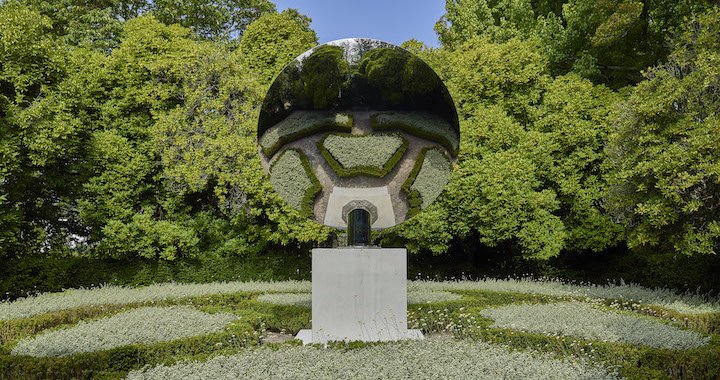
A few destinations for summertime cultural journeys
Arterritory.com’s guide to this summer’s most vivid environmental art objects and exhibitions. From Anish Kapoor in Norway and Portugal to Tony Cragg in Valencia and New York City
13/07/2018
“I don’t think it’s difficult to find a place to put a sculpture. Quite the opposite, it’s exciting, because wherever you put it, it creates a relationship,” well-known British sculptor Tony Cragg said in an interview with Arterritory.com a couple of months ago, adding that sculpture creates a new reality. “That’s what I think is exciting – the idea of expanding the idea of reality we have around us.”
This summer in Valencia, Cragg’s sculptures will be exhibited for the first time on water. But he’s not the only one – Christo has constructed a gigantic version of his life’s work, the Mastaba, on The Serpentine, a lake in London. Ernesto Neto, for his part, has installed the GaiaMotherTree meditation space in one of the busiest urban hubs, Zurich’s main railway station. It’s an opportunity to experience a different reality from the one we live in on a daily basis that has, ironically, instantly become an Instagram hit.
Environmental art objects have become an integral element of the summertime art scene, sometimes even serving as inspirational “hooks” pulling us to places where traditional tourist routes might not take us or, conversely, letting us see and enjoy well-known sites from a completely different perspective. Arterritory.com offers this guide to the summer’s most vivid environmental art objects/exhibitions for inspirational cultural journeys!
Anish Kapoor in Norway (Moss) and Portugal (Porto)
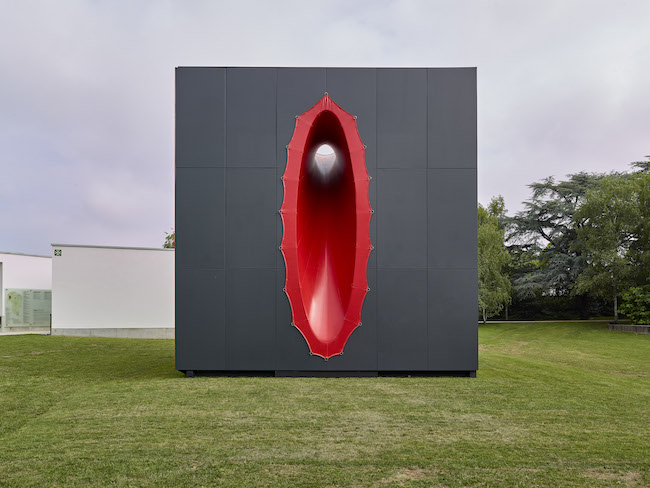
Anish Kapoor. Serralves Contemporary Art Museum and Serralves Park, Porto, Portugal. Exhibition view. Publicity photo
“Artists don’t make objects. Artists make mythologies,” once said Mumbai-born Anish Kapoor, now based in London and one of the most notable sculptors of his generation. A defining characteristic of Kapoor’s art has always been the gigantic size and simplicity of the objects he creates – an almost elusive co-existence of contemporaneity and mythology. It’s abstract poeticism with an equally strong dose of visual and emotional potency. Although Kapoor uses a variety of materials, ranging from rock to mirrors and colour pigments, his objects are at once material and immaterial, like a puzzle saturated with multi-layered symbolism that both fascinates and stirs up an existential discomfort. His artwork tears down and manipulates our preconceptions about space and our individual existences. Like in a labyrinth of sensations, we can go astray in them, momentarily and almost claustrophobically lose our balance only to regain it with a slightly altered, nuanced sense of self. In any case, it’s impossible to fully understand Kapoor without having experienced his work.
This summer, Kapoor’s work is simultaneously on show in two quite atypical locations for retrospectives of his art: the relatively small town of Moss in Norway, and Porto in Portugal. Lying 58 kilometres from Oslo, Moss has a population of only slightly more than 30,000. The town is known for two things: it was historically the industrial centre of Norway, and it is home to Galleri F15, the country’s oldest gallery of contemporary art.

Anish Kapoor. White Sand, Red Millet, Many Flowers, 1982. Photo: Istvan Virag
According to Dag Aak Sveinar, the gallery’s director, the idea for this exhibition arose during a conversation he had with Alnoor Mitha, a senior research fellow at the Manchester School of Art and co-curator of the present exhibition. “The curatorial aim and ambition was to show a comprehensive exhibition that brought together important earlier works going back three decades, from the 1980s to the present. We wanted to show a coherent body of Kapoor’s oeuvre, with iconic work that the artist acknowledges as his major inspirations – a notable example being White Sand, Red Millet, Many Flowers – and other works that have transformed both his artistic career and his global reputation as a prolific artist of our generation.
“This exhibition is not a retrospective show,” continues Sveinar. “Its main purpose is to map Kapoor’s artistic journey through public and private collections from both the UK and Norway. Through our continued meetings at the artist’s studio and discussions with several collectors and galleries, the project has become more of a collaboration between our respective venues and the Arts Council England, the British Council, the Lisson Gallery in London, private loans from Norway, and the artist’s studio.
“This exhibition, titled simply Anish Kapoor, captures the artist’s creative legacy and the vast complexity and materiality in scale, colour, form and tactility. In many ways, the work translates a binary of visual narratives on the one hand, with Kapoor’s work reminiscent of Japanese haiku poetry in its transformation of deep and significant meaning into a meditative and exhilarating experience. On the other hand, each work enhances an ostensibly perceptive identity. There’s an immediate visual feast of harmony and timelessness. We hope that, like ourselves, our audiences will be mesmerised by the sheer exuberance of colour and the dualities of ‘being and nothingness’ that Kapoor offers.
“Moreover, the ambition of our project presents Anish Kapoor’s works on this unique island in the Oslo fjord, named Jeløy, outside the town of Moss and on the Alby estate, in its sumptuous garden and at the main house. This place and its qualities are an inspiration to our local and international audiences and also greatly so for this project.”
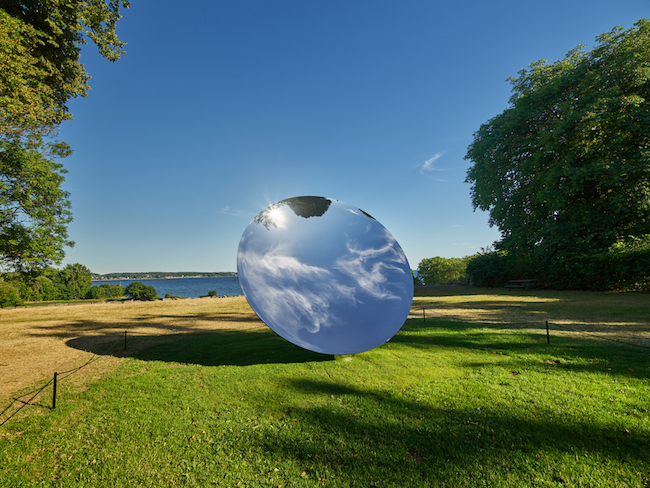
Anish Kapoor. Sky Mirror, 2018. Exhibition in Moss, at Gallery F 15. Stainless steel, diameter 330 cm. Photo: Istvan Virag
One of the central works of art in the exhibition is Sky Mirror, which has been set up in the gallery’s Baroque-style garden. It was lent to the exhibition by Kapoor’s own studio. It should be mentioned that the previous large exhibition at Galleri F15 was devoted to the legendary Norwegian artist Edvard Munch (2016). “Munch became a world-famous artist in 1912 at the Sonderbund art exhibition in Cologne, similarly to Anish Kapoor with his outstanding inaugural exhibition at the Venice Biennale in 1990. Both artists have a common international presence and also the ability through their art to give form to invisible and existential concepts in our lives,” says Sveinar.
Meanwhile, in Porto, the exhibition Anish Kapoor: Works, Thoughts, Experiments is Portugal’s first extensive retrospective of Kapoor’s work. It is on show at the Serralves Museum of Contemporary Art, designed in 1991 by architect Álvaro Siza and surrounded by an 18-hectare park created in the 1930s by French landscape architect Jacques Gréber. With this unique location in mind, Kapoor himself selected the pieces to be exhibited in the park, with the artist-directed route past the works of art feeling almost like a ritual experience of feelings and sensations. Those lucky enough to visit both the Norway and Portugal exhibitions will be able to enjoy the various faces of the iconic work titled Sky. The version exhibited in the Rose Garden at the Serralves Museum is a 3.2-metre disc of polished stainless steel reflecting the ever-changing world around it as well as the ever-changing viewers. It reveals the so-called “third space” between the material and immaterial, between the earth and sky. Serralves Park also includes pieces from the artist’s more recent series, for example, Bird Language, as well as Kapoor’s experiments in the field of architecture.
Anish Kapoor
Albyalléen 60, Alby gård 1519 Moss, Norway
From June 30 to October 4
Anish Kapoor: Works, Thoughts, Experiments
Serralves Museum of Contemporary Art
Rua D. João de Castro, 210; 4150-417 Porto, Portugal
serralves.pt
From July 6 to January 6, 2019
Sol LeWitt’s Nine Towers (for Jene) at the Kivik Art Centre in Sweden
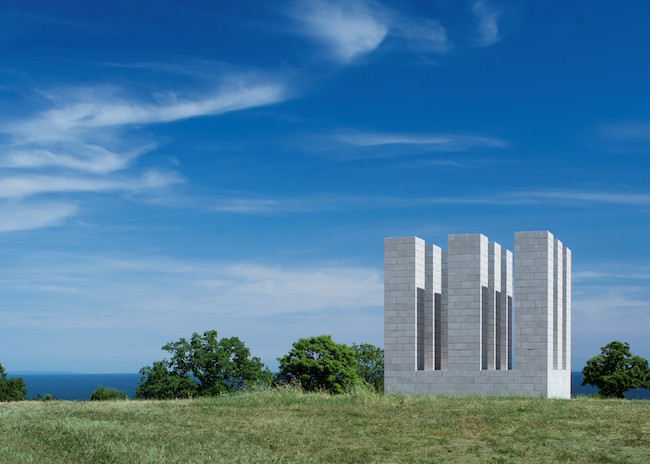
Sol LeWitt’s Nine Towers (for Jene). Photo: Gerry Johansson
Sol LeWitt’s Nine Towers (for Jene), set up at Sweden’s Kivik Art Centre in late June, is a beautiful and also emotional project to which the artist gave his blessing shortly before his death. The Kivik Art Centre is located in southern Sweden – relatively in the middle of nowhere, with the nearest smaller towns being Simrishamn and Ystad and the nearest large cities being Malmö and Copenhagen. The man behind the park’s concept is Sune Nordgren, one of Sweden’s most influential art curators. He calls his relationship with this site, which began more than 12 years ago, a kind of “love affair”. When he can no longer keep up with the current pace of his life, he plans to spend his retirement right there, near Kivik.
“When we began this project, our focus was on the interaction between art and architecture. At first, it was architects whose work bordered on art. Now, as in the case of LeWitt, they’re artists whose creations border on architecture. The first seven or eight years were like an introductory period, during which we introduced people with the project. Now they’re familiar with Kivik, and we get about 20,000 visitors a year. I don’t think we even need many more than that. It’s hard to find the park without a navigation system. We want to provide people with an experience of both art and nature – the opportunity to get away from everything for a day. And that’s why we don’t really specially advertise the park,” Nordgren has said in an interview with Arterritory.com.
Nine Towers is a five-metre-tall sculpture constructed of almost 4000 white cement blocks (20x20x40 cm) made specially for this project. It is the only work of environmental art by the American artist and pioneer of minimalism Sol LeWitt (1928–2007) in the Nordic region. Although it is a significant example of his artistic style, it was built using materials and forms of expression characteristic of architecture. In addition, it serves as a kind of pillar and temple, challenging viewers both visually and physically. The object’s geometric precision and laconic nature accent the surrounding landscape and the beauty of the Baltic Sea in the distance. And the comment expressed in the work’s title – a dedication to Jene – refers to a very special relationship, namely, the friendship and exchange of creative ideas between LeWitt and American sculptor Jene Highstein (1942–2013).
Nordgren long dreamed of realising this project, and the challenge took several years, involving a search for sponsors and even an extensive crowd-funding campaign. Thus a total of almost 600 people have supported the initiative.
In addition to LeWitt’s Nine Towers, the Kivik Art Centre also features work by the Norwegian architecture office Snøhetta, well-known architect David Chipperfield, artist Antony Gormley and others.
Ernesto Neto at Zurich’s Main Railway Station

Ernesto Neto, GaiaMotherTree (2018). Zurich Main Station. Fondation Beyeler. Photo: Mark Niedermann
Brazilian artist Ernesto Neto is known for artwork that involves almost all of the senses – touch, sight, hearing, smell – letting viewers wander through, touch, delve into, wade into, forget themselves and find themselves anew in his gigantic installations (Neto himself calls them sculptures), whose abstract forms take on nearly human form. Perhaps ‘lightness’ is the most precise description of Neto’s work. Not physical lightness, but the lightness of feeling, of an unleashed mind, of sensuality.
Since 2014 and his meeting with the Huni Kuin tribe living near Brazil’s border with Peru, Neto’s mission has been to renew the long-lost link between indigenous tribes and Western civilisation, between humans and nature. According to Neto, we have almost destroyed the world, and only by returning to our roots can we save it. “We are nature. And culture is only a sub-project of nature,” he explained in an interview with Arterritory.com.
Neto continues his series of artwork devoted to this theme with the large-scale installation on view until the end of July in the main railway station in Zurich. The monumental work is called GaiaMotherTree, and the 40x28-metre object made of brightly coloured cotton string resembles a huge tree stretching 20 metres up towards the “sky” that is the ceiling of the station building. It was made entirely by hand over the course of several weeks, with 17 people from the artist’s studio and 17 more assistants specially invited to work on the project. In all, it took three months to complete the installation, and it spent another month on a ship travelling from Brazil to Switzerland. In a style characteristic of Neto’s artwork, GaiaMotherTree’s “branches” hang like gigantic tears and are filled with 420 kilograms of spices: turmeric (140 kg), cloves (140 kg), caraway (70 kg), black pepper (70 kg) and various seeds (70 kg).
The name Gaia comes from ancient Greek mythology and personifies the Earth emerging out of Chaos, thereby becoming the origin of everything. At the heart of Neto’s installation is Mother Earth, and the carpet that lines its interior bears a map of the world with the Atlantic Ocean at its centre. The silhouette of the tree recalls the Biblical Garden of Eden, while the cushions inside the installation are shaped like snake heads. GaiaMotherTree also symbolises the reciprocal links existing in the plant kingdom, such as the “underground conversations” that take place between trees, in which their roots exchange nourishment and information. For example, according to scientists at the University of British Columbia in Vancouver, a tree that has been attacked by pests alerts other trees with the help of its root system. Although in Western civilisation conscious actions are not attributed to the plant kingdom, indigenous tribes in Brazil believe otherwise, their shamans – with the involvement of ayahuasca and other rituals – acting as mediators between nature and the human world.
GaiaMotherTree was created in collaboration with the Fondation Beyeler in Basel. Visitors can step inside the installation, which serves as a space for meditation and meetings, and the project also includes a series of workshops, readings and concerts. Needless to say, in the very first few days after Neto’s installation was set up, Zurich Main Railway Station – a building that is more than 150 years old – had already become an Instagram hit.
Until July 29
Art biennial in Saint-Paul de Vence

Antony Gormley. Big Switch, 2014. Cast iron, 295 x 59 x 50 cm. Installation view, Biennale Internationale Saint-Paul de Vence, Saint Paul de Vence, France, 2018. Photograph by Loïc Deltour © the artist
The recent glut of new art biennials is joined this summer by a biennial in the charming town of Saint-Paul de Vence in southern France. In fact, the event continues – in contemporary fashion – a tradition that began in this very area in the early 20th century, when the special landscapes and light here literally turned Saint-Paul de Vence into a magnet for artists. As one of those bewitched by the region, Marc Chagall once remarked that, “There, in the south, for the first time in my life, I saw that rich greenness – the like of which I had never seen in my own country. I thank destiny for leading me to the shores of the Mediterranean.”
Chagall moved to Vence in the 1950s, and there he met his second wife, Valentina, nicknamed Vava. In 1966, at age 80, he moved to Saint-Paul de Vence, a village up in the mountains above the more commercialised town of Vence. The works of art he produced in the South of France are true odes to love – couples surrounded by flowers with blue skies in the background, and so on. Chagall could often be met at the Colombe d’Or and the Café de la Place, cafés that had already gained iconic status. His friends included the legendary art dealers Aimé and Marguerite Maeght, whose home, Le Mas Bernard, was right next door to Chagall’s. Today, many works of art by Chagall can be seen at the Fondation Maeght, including the grandiose mosaic Les Amoureux by the entrance to the building. The artist’s grave is also located in Saint-Paul de Vence, in “the most Mediterranean of cemeteries in the Mediterranean region”.
The Fondation Maeght has now become one of the venues for the first Biennale Internationale Saint-Paul de Vence, hosting My Nation: The Imagination, an exhibition of work by the Belgian artist Jan Fabre. On show until November 11, it focuses on Fabre’s sculptures (and particularly his works in marble) as well as his drawings, which reflect on the relationships we have with our bodies, minds, dreams and imaginations in dialogue with scientific studies and the twists and turns of consciousness inspired by the muses. The exhibition is an experience in feelings and the senses worthy of Fabre himself, at once embodying seriousness as well as a healthy dose of humour.
Artwork is exhibited at several other locations throughout the town as well. For example, British sculptor Antony Gormley’s Big Switch (2014), which is a part of his “Big Blockworks” series and is inspired by the idea of using construction materials as physical pixels. Over time, the series has grown in size and scope, with Gormley – like a child playing with blocks – building gigantic forms resembling human silhouettes. The simple, solid, stable structures celebrate the link between the body and the earth and also call to mind associations with such fundamental architectural structures as Stonehenge or Mies van der Rohe’s buildings. Big Switch, which weighs two tonnes (the pedestal alone weighing 1.6 tonnes) stands on Saint-Paul de Vence’s old defensive wall.
In all, seventeen artists are participating in the biennial, four of whom have created new works of art specifically for this event.
Until August 31
bis-art.com
Sculpture Mile in London

Sarah Lucas, Perceval (2006). © Sarah Lucas, courtesy Sadie Coles HQ, London. Photo: Nick Turpin
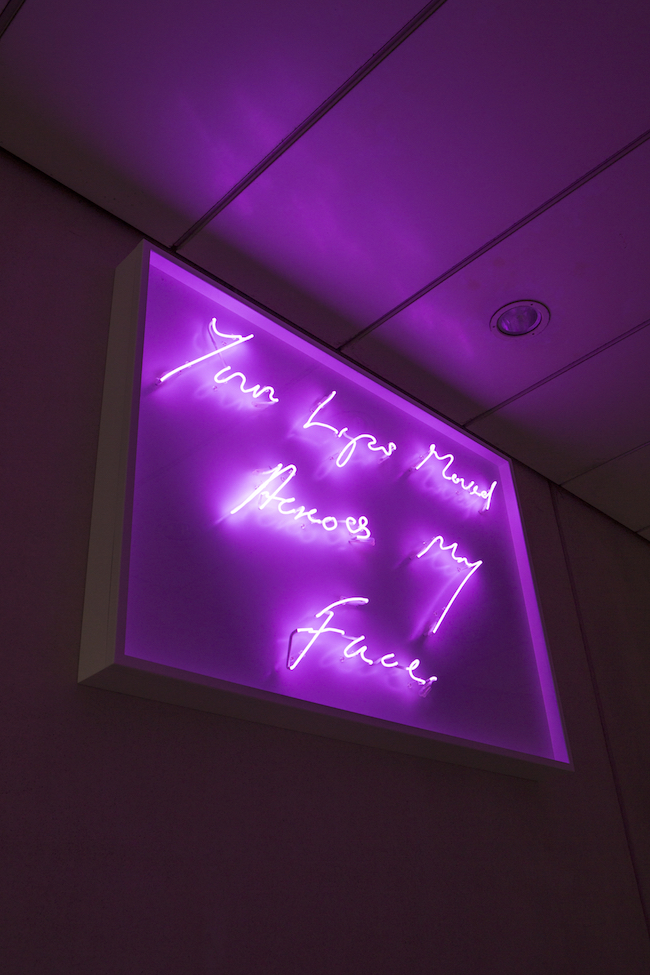
Tracey Emin. Your Lips Moved Accross My Face, 2015. © Tracey Emin un Lehmann Maupin
Sculpture in the City – also known as Sculpture Mile – is a project that has already become a summer tradition of sorts in London. Organised by the City of London, for the past eight years works of contemporary art have been exhibited in unusual locations throughout the city. This year is significant for the fact that nine of these works of art have been made by women, thereby commemorating 100 years since British women won the right to vote. Among the artists are Marina Abramović and Sarah Lucas as well as Tracey Emin. Abramović’s sound installation Tree (1972) can be seen at 99 Bishopsgate, while Lucas’ Perceval (2006) – a life-size bronze sculpture of a horse pulling a cart filled with two gigantic marrows (phallic symbols) made of concrete – has been set up on Cullum Street. Emin is represented by her neon pink work titled Your Lips Moved Across My Face (2015), located in the passageway connecting Bury Court and Bury Street. Typical of Emin’s style, it consists of a line that seems to have come from her own diary but could just as well be the beginning of a romantic entry intended to be continued by the viewers themselves. This year, Sculpture in the City features a total of eighteen artists.
cityoflondon.gov.uk
From June 27 to June 27, 2019
Christo’s Mastaba on The Serpentine in London

Christo and Jeanne-Claude. The London Mastaba, 2016-18. Photo: Wolfgang Volz © 2018 Christo
“I think it’s a much bigger challenge to create things that will be lost instead of things that will remain,” once said Christo, the best-known environmental artist of the 20th and 21st centuries. One of his most ephemeral projects can currently be seen on The Serpentine, a lake in London’s Hyde Park, until September 9. It consists of 7506 barrels stacked horizontally to form a 20-metre-high, 30-metre-wide, 40-metre-long floating installation titled The London Mastaba. The bright blue and red colours of the gigantic pile of industrial barrels weighing more than 600 tonnes plays surreally against the lake’s water, the duck and swan families swimming in it, and also the people who come here to relax and lazily glide across the water in pedal boats.
Mastaba was inspired by the clay houses of ancient Mesopotamia, whose shape was later adapted for use as tombs by the Egyptians. Christo and his late wife and creative companion, Jeanne-Claude, made the sketches for this project more than 50 years ago. Only in 2016 was it physically built for the first time. Back then, it was only nine metres tall and stood in the courtyard of the Fondation Maeght for just a short time as a part of Christo’s exhibition there.

Christo and Jeanne-Claude. The London Mastaba, 2016-18. Photo: Wolfgang Volz © 2018 Christo
The London Mastaba is Christo and Jeanne-Claude’s first major work of environmental art in London, and, like all of the other works the pair made together, was created for a specific location, is not transportable and will be demolished when the exhibition is over. As a unique aesthetic and intellectual experience it will exist for only a short time. “The installation’s colours change according to the light, and its reflection in The Serpentine resembles an abstract painting,” Christo has said. Meaningfully, the project was fully funded by the artist himself, with money gained from selling other, smaller works of art. He emphasises that he does not accept sponsorships. A simultaneous exhibition at the Serpentine Gallery looks back on 60 years since Christo and Jeanne-Claude began using barrels in their artwork.
One of Christo’s dreams is to create a permanent Mastaba installation in Abu Dhabi’s desert. Work on this project began in 1973, and, if it is realised, it will become the only permanent large-scale installation by Christo and Jeanne-Claude as well as the world’s largest sculpture. It is intended to be 150 metres tall and 300 metres wide and will be made of oil barrels painted to match the surrounding landscape.
Kensington Gardens, London W2 3XA
Until September 9
Tony Cragg’s sculptures in Valencia and on Park Avenue in New York City
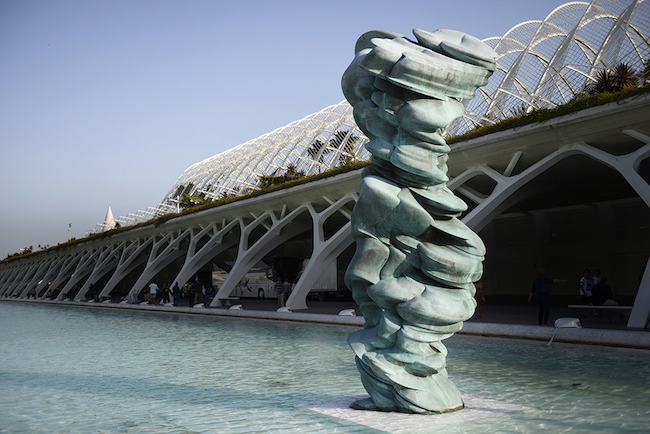
Tony Cragg. Ciutat de les Arts i les Ciències, Valencia. Publicity photo
“Sculpture is reality,” says Tony Cragg. “It’s not an image, it’s not an illusion. It’s a part of reality. I mean, we use material all the time – we get dressed, we are sitting on the chairs in a house, walking on the streets, etc. All this is part of the human strategy for survival, which works well at times and has definitely brought us to where we are now. But this use of materials is utilitarian. And because it is utilitarian and made today, made industrially, it uses certain geometries, certain economic geometries. For example, we have machines that turn and make straight lines. And everything made industrially is flat – straight edges, ninety degrees, and very uninteresting. (...) It’s depressingly boring. The industrial production systems drive our use of material, resulting in the impoverishment of form on this planet.
“Except for some high research areas, sculpture is the only use of material that is not utilitarian and provides us with new forms. It doesn’t use the same dumb, stupid geometry; it’s not repetitive, and it produces new ideas, new emotions, new language and new freedoms. It’s the cutting edge of what one does with material. I think that’s what sculpture is and why it’s important for me,” Cragg said in an interview with Arterritory.com.
Over the course of his almost 50-year-long career, the well-known British sculptor has organised more than 350 solo exhibitions. In 1988 he represented Great Britain at the 43rd Venice Biennale and also received the Turner Prize that same year. Already as a young child, Cragg was interested in science and natural history. He began collecting fossils as a child, and today he says that he sees human-made objects as “fossilised keys to a past time which is our present”. Still today, this long-standing interest in palaeontology continues to inspire him as an artist, and therefore it could be said that, in a way, the Ciutat de les Arts i les Ciències (City of Arts and Sciences) in Valencia, where six of Cragg’s sculptures have been displayed this summer, forms a very appropriate symbolic backdrop to his work. Four of the sculptures are situated in the ponds surrounding the arts and sciences centre, which is a new experience for Cragg, because until now his work has never before been exhibited on water. He used a variety of materials to make the sculptures – bronze, steel, fibreglass – and some of the sculptures reach a height of six metres and weigh up to 4000 kilograms.
Alongside the exhibition in Valencia, five of Cragg’s sculptures can be seen on Park Avenue in New York City until the end of October.
Av. del Professor López Piñero, 7; Valencia
Until November 4